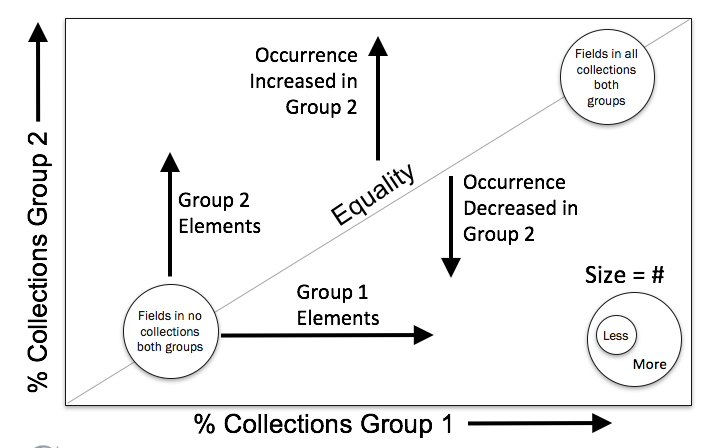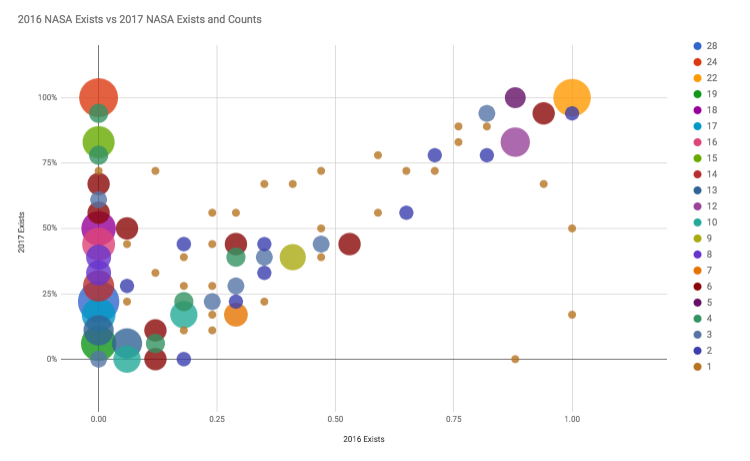Table of Contents
Overview
The purpose of this evaluation is compare the usage of elements in NASA metadata collections during 2016 and 2017 in order to describe and visualize how NASA metadata collections are evolving over time.
Data Selection
Table 1 below shows the collections included in this evaluation as well as the record count and change in number of records for each collection.
Table 1. Collections and record counts
| Collection | 2016 Count | 2017 Count | Change | Collection | 2016 Count | 2017 Count | Change | |
| ASF | 84 | 161 | 77 | LPDAAC_ECS | 185 | 285 | 100 | |
| CDDIS | 28 | 38 | 10 | NSIDC_ECS | 197 | 223 | 26 | |
| GES_DISC | 35 | 1044 | 1009 | NSIDC_V0 | 784 | 784 | ||
| GHRC | 339 | 361 | 22 | OB_DAAC | 63 | 132 | 69 | |
| GSFCS4PA | 687 | -687 | OMNIRT | 4 | 5 | 1 | ||
| LAADS | 78 | 130 | 52 | ORNL_DAAC | 1135 | 1216 | 81 | |
| LANCEAMSR2 | 5 | 6 | 1 | PODAAC | 375 | 603 | 228 | |
| LANCEMODIS | 116 | 154 | 38 | SEDAC | 202 | 202 | ||
| LARC | 343 | 406 | 63 | USGS_EROS | 11 | 11 | 0 | |
| LARC_ASDC | 495 | 606 | 111 | Total | 4180 | 6367 | 218 |
Note:
- GSFCS4PA 2016 records were moved to the GES_DISC collection in 2017
- NSIDC_V0 and SEDAC were not included in the 2016 analysis
NASA 2016 vs NASA 2017
This analysis compares element usage in 17 NASA 2016 collections with element usage in 18 2017 collections. This evaluation identifies elements which exist in collections even if they are incomplete. In order for an elements to exist in a collection it must be present in at least one metadata record included in the collection.
Presentation
Element usage for NASA 2016 collections and NASA 2017 collections is shown below using bubble chartsFigure 1. The bubble chart interpretation graphic provides a schematic for interpreting the bubble plots.
Figure 1. Bubble Chart Interpretation
NASA 2016 Exists vs NASA 2017 Exists
Chart 1 below compares element existence in 2016 NASA Collections with 2017 NASA collections. The X axis shows the percent of NASA 2016 collections that include an element. The Y axis shows the percent NASA 2017 collections that include an element. The bubble size shows the number of elements at each location on the chart.
The large bubble in the upper left corner of the plot shows represents elements that exist is 100% of NASA 2017 collections and 0% of NASA 2016 collections. This bubble includes 24 elements, as shown in the legend. The large bubble in the upper right corner of the plot shows represents elements that exist is in 100% of NASA 2016 and 100% of NASA 2017 collections. This bubble includes 22 elements, as shown in the legend. Click the chart or this link to view the data.
Chart 1: NASA 2016 EXIST Exists vs NASA 2017 Exists
Accessing the Data
Click on the chart graphic above to view an interactive version of the data for this chart that the data sheet for this chart. The data sheet enables data identification for each bubble, and includes a look up table for identifying the ISO elements associated with the bubble. To access and use the interactive version:
- Click on the chart graphic above to view the data
- Hover over the bubbles with your mouse to identify the concept existence in 2017 NASA collections and concept existence in 2016 NASA collections associated with the bubble. The hover identification also shows the number of elements (Counts) associated with each bubble.
- To the left of the chart is a lookup table for identifying the xpaths associated with each of the bubbles. To identify the xpaths associated with a bubble, match the NASA Exists and Other Exists values from the bubble hover with the values in the look up table.
Elements in all NASA 2016 and NASA 2017 Collections
Twenty-two elements exist in all NASA 2016 collection and all NASA 2017 Collections. These elements are indicated in the large bubble in the upper right corner of the chart. To identify these items, click here to access the spreadsheet and select the All 2016 and All 2017 filtered view from the toolbar.
Elements in all NASA 2016 Collections and some NASA 2017 Collections
Four elements exist in all NASA 2016 Collections and in a smaller number of NASA 2017 collections. These elements are shown as three bubbles along the right edge of the chart. To identify these items, click here to access the spreadsheet and select the All 2016 and Some 2017 filtered view from the toolbar.
Elements in some NASA 2016 Collections and all NASA 2017 Collections
Five elements exist in all NASA 2017 Collections and in a smaller number of NASA 2016 collections. These elements are shown as a purple bubble on the top edge of the chart. To identify these items, click here to access the spreadsheet and select the All 2017 and Some 2016 filtered view from the toolbar.
Elements in some NASA 2016 Collections and No NASA 2017 Collections
Twenty-one elements exist in some NASA 2016 Collections and in no NASA 2017 collections. These elements are shown as bubbles along the lower edge of the chart. To identify these items, click here to access the spreadsheet and select the Some 2016 and No 2017 filtered view from the toolbar.
Elements in No NASA 2016 Collections and some NASA 2017 Collections
Forty-eight elements exist in some NASA 2017 Collections and in no NASA 2016 collections. These elements are shown as bubbles along the left edge of the chart. To identify these items, click here to access the spreadsheet and select the Some 2017 and No 2017 filtered view from the toolbar.

